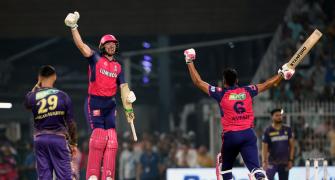The 7th CPC places the Indian Police Service (and, almost in passing, the Indian Forest Service) on a level with the Indian Administrative Service, leaving the military out in the cold, observes Ajai Shukla.

Where you stand on the recently released Seventh Central Pay Commission report depends upon where you sit. Macro-economists, viewing the report through the lens of fiscal prudence, might conclude the commission has been overly generous. Surprisingly, many central government employees who are beneficiaries of this largesse would partially agree. Viewing remuneration through the lens of cut-throat inter-service competition, most would complain the commission has given too much to rival services and too little to their own. Even more than absolute benefits, each service wants to gain relative to rival services, since this determines relative seniority and status. Employees of service X would applaud a Rs 5,000 raise, in tandem with a Rs 3,000 raise for services Y and Z, more than they would a Rs 10,000 raise across the board.
In this relative sense the clear gainers from the 7th CPC are the Indian Police Service and the Indian Forest Service, assuming the government implements the CPC report in toto (historically, governments have added benefits to what CPCs recommended). The biggest relative loser is, once again, the military. Historically, even while it has demanded parity with the Indian Administrative Service and the Indian Foreign Service, the army has been equated with the IPS, much to its chagrin. Now, even worse, the 7th CPC places the IPS (and, almost in passing, the IFoS) on a level with the IAS.
To see how this so, start at the beginning. There are two main categories of central government employees: the “All India Services” -- the IAS, IFS, IPS, IFoS and the military. The second is Organised Group “A” Services -- Customs & Excise, Railways, Border Roads Organisation, Indian Ordnance Factory Service, and a host of others.
The 3rd CPC, which was convened in 1970 (and the first without a military member), formally granted the IAS and IFS superiority over all other services. In justification, it argued that “an IAS officer gets an unequalled opportunity of living and working among the people, participating in planning and implementation of developmental programmes, working with the Panchayati Raj institutions, coordinating the activities of government departments in the district and dealing directly with problems of law and order”. Given this responsibility, the IAS and IFS were granted an extra increment at three successive seniority grades to which IAS officers are usually promoted at four, nine and 13 years of service respectively. Thus, by the time IAS/IFS officers had served 13 years, they had three increments more than contemporaries in other services. This lead in pay, seniority and status continued for the rest of their service.
The 7th CPC’s bombshell recommendation, tucked away on Page 151, is that this relative advantage enjoyed by the IAS/IFS should be extended to the IPS and the IFoS, leaving the military out in the cold. After having hotly debated this issue, the 7th CPC report notes: “The chairman is of the view that the fundamental principle for determining the remuneration for any position is that it should be based on the complexity and difficulty of the duties and responsibility of the job in question. The criticality of functions at the district administration level holds good equally for the IAS, IPS as well as the IFoS. Therefore, some additional remuneration, in the early stages of their career indeed is justified not only for the IAS but also for the IPS and IFoS”.
Furthermore, the advantage over the military will now be doubled. The chairman has recommended the IAS/IFS edge “may continue in the form of two additional increments at three per cent each in the proposed pay matrix. The same is being recommended for Indian Police Service and Indian Forest Service as well. In so far as the Indian Foreign Service is concerned, the existing dispensation shall continue”.
Effectively, this means IAS, IPS and IFoS officers will get six additional increments by the time they complete 13 years of service. The military gets nothing, apparently in the continuing belief that its functions are not as complex, difficult and critical as the other four All India Services.
With the IAS advantage threatened, Vivek Rae -- the former IAS official on the 7th CPC -- has dissented. His six-page dissent note justifies a continued financial edge for the IAS, since its officers “occupy the commanding heights of the civil service structure not through patronage, but through a highly competitive and transparent selection process.”
This false notion of a difficult selection process is rejected by the third member, Rathin Roy, who correctly points out that IAS/IFS officers are selected in a common selection process with the IPS and IFoS. Roy concludes that no special attributes can be ascribed to the former, and that “no edge should be granted to any service purely by virtue of belonging to such”.
This unprecedented discrimination against the military is being justified in a trickle of newspaper articles that argue untenably that the military benefits from attractive allowances, especially military service pay.
However, the figures tell another story. There are less than 50 military allowances, compared to about 90 for civilian officials. Moreover, a large number of military allowances have been subsumed into a “risk-hardship matrix”, in which every military posting gets a standard allowance based on the “risk” and “hardship” profile.
The Siachen Glacier, which has the highest degree of both risk and hardship, brings soldiers posted there an allowance of Rs 31,500 per month. In contrast a civilian bureaucrat from the All India Services draws 30 per cent of his salary as “hardship allowance” when posted anywhere outside what officials regard as a comfort zone. For example, a senior IAS official posted in Guwahati will draw Rs 70,000 per month as “hardship allowance”, compared to Rs 31,500 per month drawn by military officers in Siachen.
Military personnel draw MSP, like other militaries the world over, to compensate for the “intangible hardships” of military service, including separation and risk. In the UK, where it is called ‘X-Factor Pay’, it is calculated at 15 per cent of salary. In India, where MSP is only paid to brigadiers and below, it is under 10 per cent for most. There was similar heartburn over “entitled rations” that military personnel drew. But no longer; the 7th CPC withdraws “entitled rations” in peace stations.
IAS bureaucrats like to argue that pay and status are not linked. Yet, in practice, pay determines status. Already, senior police officials in Jammu & Kashmir decline to attend meetings of the United Headquarters, a top-level body that meets to synergise army, police and bureaucratic efforts to tackle extremism. The policemen’s logic: they are senior to the UHQ chairman (the army corps commander) because they draw higher salaries. Once the 7th CPC is implemented, and the IPS unprecedentedly elevated above the military, such problems will only be compounded.











